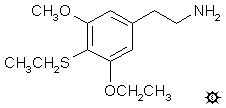
#147 4-TASB
4-THIOASYMBESCALINE; 3-ETHOXY-4-ETHYLTHIO-5-METHOXYPHENETHYLAMINE
|
| [3D .mol structure] |
To a stirred solution of 15.0 g of 3-ethoxy-2-(ethylthio)anisole in 100 mL CH2Cl2 there was added 12 g elemental bromine dissolved in 25 mL CH2Cl2. There was the copious evolution of HBr. After stirring at ambient temperature for 3 h, the dark solution was added to 300 mL H2O containing sodium dithionite. Shaking immediately discharged the residual bromine color, and the organic phase was separated, The aqueous phase was extracted once with 100 mL CH2Cl2, the pooled extracts washed with dilute base, and then the solvent was removed under vacuum to give a light brown oil. This wet product was distilled at 112-122 °C at 0.3 mm/Hg to yield 4-bromo (and/or 6-bromo)-3-ethoxy-2-(ethylthio)anisole as a light orange oil. This was used in the following benzyne step without separation into its components.
To a solution of 36 mL diisopropylamine in 150 mL anhydrous THF under a He atmosphere, and which had been cooled to -10 °C with an external ice/MeOH bath, there was added 105 mL of a 1.6 M solution of butylithium in hexane. There was then added 5.1 mL of dry CH3CN followed by the dropwise addition of 15.0 g 4-bromo-(and/or 6-bromo)-3-ethoxy-2-(ethylthio)anisole diluted with a little anhydrous THF. There was an immediate development of a dark red-brown color. The reaction was warmed to room temperature and stirred for 0.5 h. This was then poured into 600 mL of dilute H2SO4. The organic phase was separated, and the aqueous fraction extracted with 2x50 mL CH2Cl2. These extracts were pooled and the solvent removed under vacuum. The residue was a dark oil and quite complex as seen by thin layer chromatography. This material was distilled at 0.3 mm/Hg yielding two fractions The first boiled at 112-125 °C and weighed 3.9 g. It was largely starting bromo compound with a little nitrile, and was discarded. The second fraction distilled at 130-175 °C and also weighed 3.9 g. This fraction was rich in the product 3-ethoxy-4-ethylthio-5-methoxyphenylacetonitrile, but it also contained several additional components as seen by thin layer chromatographic analysis. On standing for two months, a small amount of solid was laid down which weighed 0.5 g after cleanup with hexane. But even it consisted of three components by TLC, none of them the desired nitrile. The crude fraction was used for the final step without further purification or microanalysis.
A solution of LAH in anhydrous THF under N2 (15 mL of a 1.0 M solution) was cooled to 0 °C and vigorously stirred. There was added, dropwise, 0.40 mL 100% H2SO4, followed by about 3 g of the crude 3-ethoxy-4-ethylthio-5-methoxyphenylacetonitrile diluted with a little anhydrous THF. The reaction mixture was stirred until it came to room temperature, and then held at reflux on the steam bath for 2 h. After cooling to room temperature, there was added IPA to destroy the excess hydride (there was quite a bit of it) and then 15% NaOH to bring the reaction to a basic pH and convert the aluminum oxide to a loose, white, filterable consistency. This was removed by filtration, and washed first with THF followed by IPA. The filtrate and washes were stripped of solvent under vacuum, the residue added to 100 mL dilute H2SO4. This was washed with 2x75 mL CH2Cl2, made basic with 25% NaOH, and extracted with 2x50 mL CH2Cl2. After combining, the solvent was removed under vacuum providing a residue that was distilled. A fraction boiling at 122-140 °C at 0.3 mm/Hg weighed 1.0 g and was a colorless oil. This was dissolved in 10 mL of IPA, and neutralized with 20 drops of concentrated HCl and diluted, with stirring, with 40 mL anhydrous Et2O. There was the slow formation of a fine white crystalline salt, which was removed by filtration, washed with Et2O, and air dried. The product 3-ethoxy-4-ethylthio-5-methoxyphenethylamine hydrochloride (4-TASB), weighed 0.5 g, and had a mp 139-140 °C. Gas chromatographic analysis by capillary column chromatography of the free base (in butyl acetate solution on silica SE-54) showed a single peak at a reasonable retention time, verifying isomeric purity of the product. Anal. (C13H22ClNO2S) C,H.
DOSAGE: 60 - 100 mg.
DURATION: 10 - 15 h.
QUALITATIVE COMMENTS: (with 60 mg) The compound has a petroleum-refinery type taste. There was a looseness of the bowels as I got into it. Here we have another of these 'What is it' or 'What isn't it' compounds. Somehow I seemed to have to push the erotic, the visual, the whole psychedelic shmeer, to document that this was indeed effective. I am not impressed.
(with 100 mg) There were some trivial physical problems during the early stages of this experiment. But there was fantasy stuff to music, and some jumpy stuff to music. Is there a neurological hyperreflexia? I was able to sleep at the 12 hour point but I felt quite irritable. I am agitated. I am twitchy. This has been very intense, and I am not completely comfortable yet. Let's wait for a while.
(with 100 mg) Music was lovely during the experiment, but pictures were not particularly exciting. I had feelings that my nerve-endings were raw and active. There was water retention. There was heartbeat wrongness, and respiration wrongness. During my attempts to sleep, my eyes-closed fantasies became extremely negative. I could actually feel the continuous electrical impulses travelling between my nerve endings. Disturbing. There was continuous erotic arousability, and this seemed to be part of the same over-sensitivity of the nervous system; orgasm didn't soothe or smooth out the feeling of vulnerability. This is a very threatening material. DO NOT REPEAT.
EXTENSIONS AND COMMENTARY: Again, another drug with more physical problems than psychic virtue, but with no obvious structural feature to hang it all onto. Some day this will all make sense!
| [ |
[Main Index] | [Forward |

